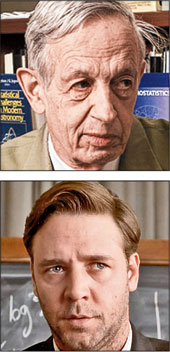
John Nash, Russell Crowe
(below) as Nash in A Beautiful Mind
New Delhi, March 26: An 86-year-old American mathematician who battled mental illness for years and gained celebrity status through the Nobel Prize, a biography and a Hollywood film has been selected for a prestigious mathematics award for what some of his peers consider his best work.
John Nash, who spent his career at Princeton University and the Massachusetts Institute of Technology, will share the Abel Prize for 2015 with Louis Nirenberg, a 90-year-old Canadian-born mathematician, the Norwegian Academy of Sciences and Letters announced yesterday.
The Academy said the two mathematicians, who worked independently but influenced each other, would receive the prize for their 'striking and seminal contributions' (during the 1950s) to a field of mathematics called 'non-linear partial differential equations'.
'Partial differential equations are a key area of mathematics with a wide range of real-world applications -from weather forecasting to Wall Street trend analysis,' said Imran Biswas, a faculty member at the Tata Institute of Fundamental Research Centre for Applicable Mathematics, Bangalore.
Nash, who was diagnosed with paranoid schizophrenia early in his career, had shared the Nobel for economics with two others in 1994 for his contributions to advancing game theory, the branch of mathematics that deals with decision-making.
But Nash's work on partial differential equations is seen by many fellow mathematicians as his 'deepest work', the Academy said in its statement. The Norwegian king will confer the Abel Prize in Oslo on May 19.
Mathematics scholars and others familiar with Nash's work say his ideas have always been recognised in mathematical circles. But what turned him into a public celebrity were the Nobel, the Pulitzer Prize-nominated biography A Beautiful Mind, and Hollywood's adaptation of the book in which Russell Crowe played Nash.
Sylvia Nasar, now professor of journalism at Columbia University, wrote the book and Ron Howard directed the film.
While Nash published his key paper on game theory in 1950, his illness shattered his career, Nasar wrote in a chapter in a 2001 anthology titled The Essential John Nash. Diagnosed with schizophrenia, Nash resigned from MIT and fled to Paris on a quixotic quest to become a world citizen, she wrote.
Over the next decade, he was in and out of mental institutions, she wrote. 'By forty, he had lost friends, family and profession. But while Nash was 'lost in his dreams', his game theory ideas touched fields 'as far-flung as economics and biology, mathematics and political science',' Nasar wrote.
Many mathematicians believe that Nash's contributions to partial differential equations have had an even wider impact across myriad fields.
'Nash proved a number of theorems that are of great significance to geometry,' said Gadadhar Misra, professor of mathematics at the Indian Institute of Science, Bangalore.
'Specifically, they say that a curved space can be embedded in ordinary Euclidean space.'
'He developed a very nice theory to solve what we call non-linear partial differential equations,' said Subbiah Sundar, professor of mathematics at the Indian Institute of Technology, Madras.
'They're used in optimising the shapes of modern cars, analysing stock market price trends, designing air bags and predicting the weather.'
Partial differential equations deal with rates of change that can be used to describe physical phenomena. But Nash showed that they are also helpful in analysing abstract geometrical objects, the Academy said in its prize announcement that describes Nash and Nirenberg as 'two mathematical giants of the twentieth century'.
Nirenberg, who worked at New York University's Courant Institute of Mathematical Sciences, produced important results until his 70s, the Academy said in its citation.
'Unlike Nash, who wrote papers alone, Nirenberg preferred to work in collaboration with others, with more than 90 per cent of his papers written jointly. Many results in a field called 'elliptical partial differential equations' are named after him and his collaborators.'










